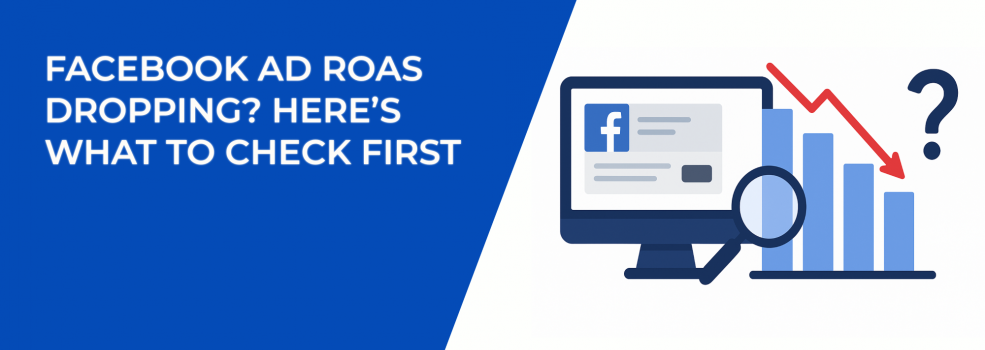If your Facebook Ad ROAS is dropping, you’re not alone. Many advertisers notice that their campaigns, once delivering strong returns, suddenly start to stall. Costs go up, conversions flatten, and performance feels unpredictable. But before you panic or scrap your strategy, it’s worth stepping back and checking a few critical areas.
Let’s break down the main reasons why return on ad spend can slip — and what you can do to turn it around.
1. Audience Fatigue
If you’ve been running the same ads for a while, chances are your audience has already seen them multiple times. High frequency leads to ad fatigue: people stop clicking, and conversions drop.
What to look at:
-
Check your ad frequency inside Ads Manager. If it’s climbing above 3–4 for cold audiences, your creative is probably getting stale.
-
Compare CTR (click-through rate) across different ad sets. A declining CTR is usually the first sign that fatigue is setting in.
How to fix it:
-
Refresh your creatives regularly — even simple tweaks like new colors, layouts, or messaging can reset performance.
-
Expand your targeting slightly to reach fresh audiences, but make sure they’re still relevant.
If you notice both CTR and conversion rate slipping, it’s a strong signal that your audience is tuning out. Don’t wait too long to make changes, because wasted impressions quickly add up.
Want a deeper dive into spotting and solving this problem? Check out our guide on Ad Fatigue on Facebook: How to Spot It Early and Fix It Fast.
2. Poor Audience Targeting
Even the best creative won’t save an ad if it’s being shown to the wrong people. Facebook’s algorithms have evolved, but targeting precision still matters.
Ask yourself: Are you targeting people who are likely to buy, or just those who might “like” your ad?
Steps to check:
-
Look at breakdowns by age, gender, placement, and device. Are certain groups converting while others waste spend?
-
Review your custom audiences and lookalikes. Are they based on strong source data, like high-value customers or repeat buyers?
Pro tip: LeadEnforce can help you refine this by targeting people who follow specific Facebook groups and Instagram pages. That way, your ads are shown to people who already engage with topics closely tied to your business.
If your audience feels too broad, you may be paying for impressions that never had a chance to convert. The opposite problem can also occur — overly narrow targeting might restrict delivery and push your CPMs higher than necessary.
Balance is key.
3. Creative-Market Fit
Sometimes ROAS drops because the message just doesn’t resonate. The creative might be polished, but if it doesn’t speak to the audience’s current mindset, results will lag.
To diagnose this, compare engagement metrics (likes, comments, shares) with conversion data. If engagement is strong but sales are low, your creative may be eye-catching but not persuasive enough to drive action.
Try this:
-
Reframe your offer to focus on urgency, exclusivity, or problem-solving.
-
Use social proof (reviews, testimonials, user-generated content) to build trust.
-
Test short-form video against static images. Often, small shifts in format can reveal what your audience prefers.
It’s easy to think creative just means “pretty design,” but in reality, it’s about aligning with what your customers care about right now. Seasonal context, cultural shifts, or even simple messaging updates can completely change how your ad performs.
Need inspiration on which ad types to experiment with? Explore The Ultimate Guide to Facebook Ad Formats for proven options.
4. Conversion Tracking Issues
Sometimes ROAS isn’t dropping because of your ads, but because your tracking setup is broken or misaligned. If events aren’t firing correctly, you may think performance is worse than it really is.
Questions to ask:
-
Is your pixel installed on all conversion pages?
-
Have you tested your events with Facebook’s Test Events tool?
-
Are you tracking the right actions (purchases, leads, signups) or relying too heavily on vanity metrics?
If tracking is off, optimization suffers too. Facebook’s algorithm relies on accurate conversion signals to find the right buyers. When those signals are missing, your delivery becomes less efficient, which drives costs up and ROAS down.
If you suspect your pixel or tracking setup is off, start with The Complete Guide to Facebook Pixel Setup and Optimization.
5. Rising Competition
If you notice CPCs (cost per click) or CPMs (cost per thousand impressions) climbing sharply, you may be dealing with more competition in the auction. This often happens during peak seasons like holidays, but it can also occur if more brands enter your niche.
To counter this:
-
Adjust your bidding strategy. Manual bidding with cost caps can help stabilize results.
-
Focus on campaign times when competition is lower, such as mid-week or off-peak hours.
-
Test narrower creatives that speak directly to a smaller but more engaged segment of your audience.
Competition is one of the hardest factors to control, but it doesn’t mean you’re powerless. Often, advertisers that adapt fastest — whether by shifting budget, testing new placements, or leaning into creative differentiation — are the ones that maintain ROAS while others struggle.
Competition in the ad auction is tough, but you can learn how to protect your budget by reading Best Facebook Ads Strategies for High-Competition Niches.
6. Weak Landing Pages
A strong ad can only carry you so far. If the landing page doesn’t convert, your ROAS will inevitably slide. Many advertisers overlook this step, but even a small change in on-site conversion rate can dramatically impact returns.
Audit your page with fresh eyes:
-
Does the page load quickly?
-
Is the offer clear and easy to act on?
-
Are distractions — pop-ups, long forms, irrelevant links — getting in the way?
Think about it this way: you’ve already paid for the click, so every lost conversion is wasted budget. Improving the post-click experience is often cheaper and more effective than constantly adjusting ad spend.
Final Thoughts
If your Facebook Ad ROAS is dropping, don’t assume it’s just the algorithm working against you. More often than not, the issue lies in creative fatigue, audience quality, tracking errors, or post-click experience.
Start by checking the basics — targeting, creatives, and landing pages — before making bigger structural changes. And remember: every campaign provides signals you can use to refine your next move. The key is paying attention and adjusting quickly.

